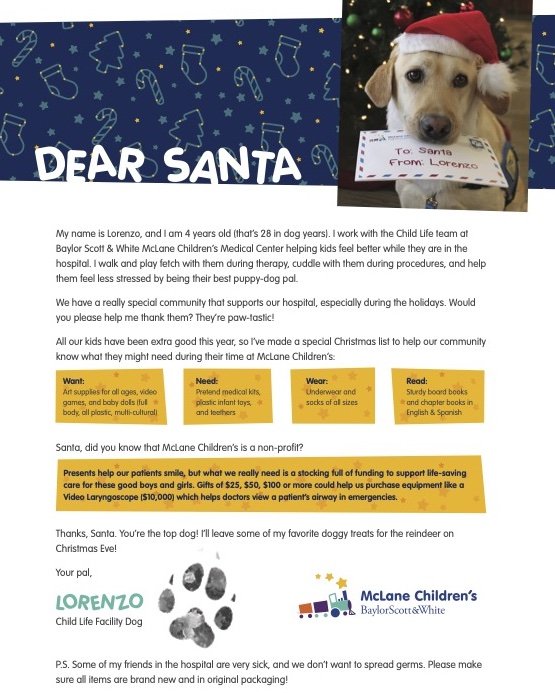Anthropomorphism? Suspect ... or secret sauce?
File under: Adapt (i.e., swipe) this successful, seasonal idea
"Dear Santa," Lorenzo, the therapy dog, wrote....
Do dogs smile?
Anthropomorphism will ALWAYS work its predictable miracles
Animal-rescue professionals (as I've learned at several chilly meetings) really, really, really HATE anthropomorphism --- the attributing of human behaviors and personality traits to other species.
On the other hand, in real life, even these science-based pros are ambivalent. You want proof?
The scene: a planning session at a sophisticated animal shelter. The top tier was in the room: all senior staff, many board members.
The mission: to figure out messaging for an upcoming capital campaign. I was at the white board, moderating.
My first question: "Can we anthropomorphize? In your campaign's case for support, can the animals talk?"
Hard NO! from everyone. Absolutely not.
Next question: "How many of you have pets at home?"
Everyone's hand went up. Many had several adopted pets.
Final question: "How many of you, as soon as you get home, talk to your pets?"
Same response, reluctantly: every hand went up. These were people who self-identified as the hard-core-iest of ANTI-anthropomorphizers ... and yet they weren't. Not really. Not when they let their hair down.
They were lovers ... talking to their fur-bearing beloveds.
So ... while they disdained anthropomorphism in their roles as animal-welfare professionals ... they happily practiced it in the privacy of their own homes.
Not a big surprise.
Countless caring humans just like them are responsible for the welfare of these (often) abandoned, neglected, abused animals.
Of course you'd speak to your pets as soon as you opened the door. Of course you'd comfort them. Of course you'd give them your full attention. Of course you'd ask after their welfare. "What's up, Badger? What did you do today? How are you feeling? Hungry? How about you, Freya? Same questions. I'm home now ... and at your service." [BTW: Badger and Freya are real-life cats tended tenderly by Ashley and Amy.]
That's what love is.
The bottom line on anthropomorphism?
It's pretty much a guaranteed money-maker with the right audience: dog lovers, cat lovers, whale lovers, wildflower lovers, creature and nature lovers of all kinds.
Effective fundraising communicators will respect, acknowledge, even try to exploit (I'm being unashamed and honest here) the power of built-in, predictable human emotions.
The corollary for nonprofit decision-makers? Don't overthink these things. Overthinking reduces giving. You have to work with what's in their brains; not with what's in your brain.
NOW: if you DO venture into anthropomorphism, do it as well as it's done by senior comms officer, Sarah Stephens, at the CTX Foundation ... on behalf of the Child Life Department at Baylor Scott & White McLane Children’s Medical Center (a renowned medical center in Temple, TX; 130 miles from Dallas-Fort Worth).
Sarah gave permission to share with you, dear reader, how they do it in Texas. She added some context:
"Every year around the holidays, the children’s hospital would get thousands of toy donations, but not necessarily the things that they needed or that followed the state rules about what they could or could not give to patients. So, for the past several years, we’ve had Lorenzo 'write' a letter to Santa with a wish list of the items most needed in the Child Life department. The letter goes out in mid-November to a group of donors who particularly support Child Life, and also gets some news media attention and posted on the hospital’s social media platforms. It’s worked wonders...."
# # #
Dear Reader: This is an excerpt from Tom Ahern’s e-newsletter. Did you miss crucial back issues of this how-to e-news? Immediately available! Just GO here. (And scroll down just a bit to sign up for Tom’s revenue-boosting tips and insights. In your inbox regularly. It’s free.)


